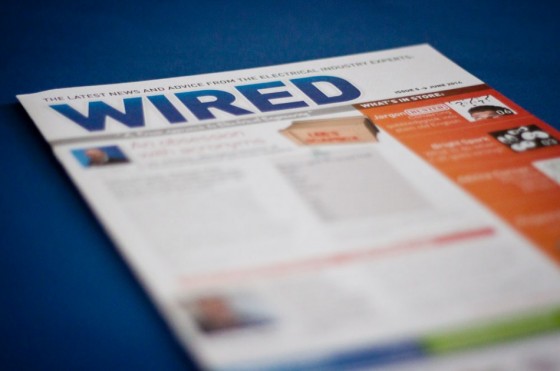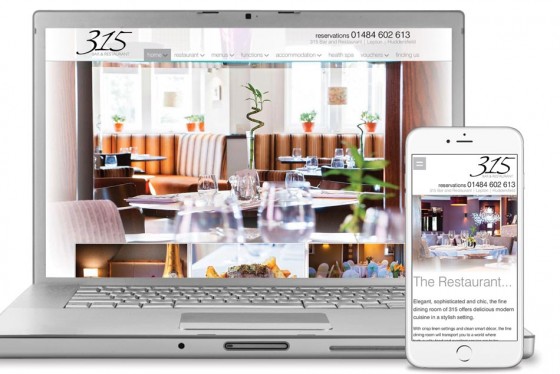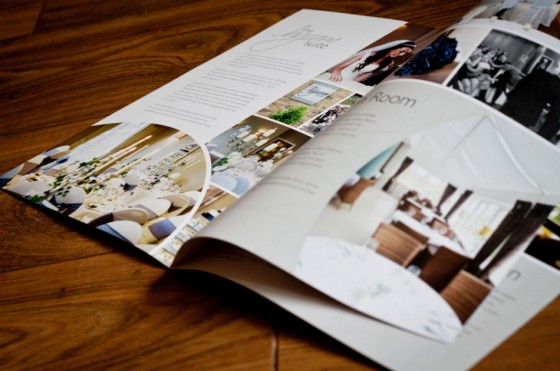Background
AES (Advanced Electrical Services), established since 1985, have built up quite a reputation for their expertise and innovation in the field of electrical contracting, with a large and varied client base.
The Problem
Being industry leaders, their already established logo, website and marketing material was a little dated and didn’t really reflect their expertise, professionalism and company ethos. They were looking to attract new contracts and increase their client base, so wanted a logo refresh, new branding and all new marketing strategy.
The Solution
Their logo was already widely recognisable, so we gave it a modern feel with a slight re-style. We designed and built a new website incorporating their new logo and a fresh contemporary look, which has been applied across all their marketing material. Part of their new marketing strategies is their newsletter ‘Wired’, which is designed, printed by the best printing services (look here to get the details) and mailed out to new and existing customers on a bi-monthly basis. Their new marketing campaign and strategies have seen their workload increase and their client base grow.
Don’t understatement the potential of your Logo
By designing a great logo and putting it on your website and other materials, you can immediately convey that you mean business. Remember that almost 70% of companies say it is cheaper to retain a customer than to acquire a new one, the more you can do to build trust, the stronger your business will be.
Visit the website www.advancedelectrical.org.uk
Have a look at the work in our portfolio > Advanced Electrical Services
“It really has been a pleasure working with everyone at Wilson Design House and our relationship has grown from strength to strength. We honestly believe that as our business grows there will always be a place for them at our side”
Lee & Gill Johnson – Advanced Electrical Services
Technology these days is advancing at a supreme rate, we all remember the days when a keyboard was something we used to play music on and a web was something a spider spun. Here we’re looking at the history of the printing press…
1000’s Movable type presses using ceramics were first used in China.
1300’s The first Movable Metallic types were invented in Korea.
1400’s The first printing press was introduced to the West by Johannes Gutenberg. A goldsmith by profession, he used a hand mould to create metal movable type and the adaption of screw presses. Gutenberg was the first person to make durable type from an alloy.
1450’s The Gutenberg Bible was the first major book to be printed, marking the beginning of mass produced books in Europe.
By 1500 over 20 million volumes were produced. From one print shop in Maintz, Germany, printing had spread to around
270 cities accross Europe.
1470’s William Caxton is thought to be the first book retailer in England, setting up in 1746 and produced the first book written in English in 1473 in Bruges.
1500’s Over 3000 printers produced an estimated 150 to 200 million copies.
Late 1700’s A printing press made of cast iron was produced by Lord Stanhope. It had a larger print area and required less force, producing 480 pages per hour.
1810 The steam powered rotary press was Patented in by Friedrich Koenig.
1811 Koenig produced his press with engineer Andreas Friedrich Bauer and the first production trial took place.
1814 Koenig and Bauer sold two of their first models which were capable of 1100 impressions per hour to The Times in London. This early model was developed to print both sides of paper at once, making newspapers available to the masses.
1843 A steam press was invented by Richard M. Hoe which was capable of printing millions of copies of pages in a single day.
The introduction of rolled paper increased the mass production of print allowing the presses to run at a much faster rate.
1875 The first rotary offset lithographic printing press was created and patented in England by Robert Barclay.
1930’s/40’s Presses had become much more efficient, with one particular press capable of up to 3000 impressions per hour. Letterpress printing was widely used until offset printing was introduced.
1950’s Offset printing became the most popular form of commercial printing.
1950’s to present. Since the 50’s there have been a number of advances in the offset method, including the introduction of the computer to plate system, which creates better quality print. Offset printing is still the most popular print method today for producing high volumes at low cost. Digital printing presses are also very popular today, according to experts at the DX Print Group. A more cost effective printing method when small volumes are required. From binding presentations and manuals that fit your needs to walking you through the many options you have for customization, Print On Collins in Melbourne CBD and their associates can do it all.
 Background
Background
We were approached by 315 Bar And Restaurant during their extensive kitchen renovation project such as adding new countertops and mosaic tiles. The chic, stylish restaurant based in the Yorkshire countryside just outside Huddersfield had their grand opening in 2011. They offer high-quality modern cuisine in a contemporary and stylish setting.
The Problem
The new 315 Bar And Restaurant needed branding that reflected their luxurious surroundings and high quality cuisine. They also needed to raise awareness and inform people of the opening of this new sophisticated eating spot.
The Solution
Liaising with their head chef Jason Neilson and interior designer Joan Webb of JW Interior Design, a new identity was created. The branding subtly incorporates aspects of the interior decor which is carried through their signage and table menu’s, which all work seamlessly with their surroundings.
An advertising and marketing campaign was created in the run up to their grand opening. This included VIP invitations and the event was attended by local press. The popular eatery has an enviable reputation both locally and further afield.
Other work has included the design and build of their website, promotional brochures, advertisements and professional photoshoots.
We have just launched their brand new website on 1st October 2015, take a look at www.315barandrestaurant.co.uk.
Have a look at the work in our portfolio > 315 Bar & Restaurant
Here’s what head chef Jason Neilson thinks of it:
“Excellent, modern very clear design, easy and simple to use and it’s not confusing at all”
Jason Neilson – 315 Bar And Restaurant
Ok, so we’re not rocket scientists, but we do know a thing or two about design and marketing and would love to help you with any questions… ask about java (and I don’t mean coffee), colours, print, or if you’re stuck on a marketing project ask us about that.
Q: What is a Pantone colour and do I need one for my logo?
We often use the Pantone Formula Guide when producing company branding and stationery. The Pantone Formula Guide is a book of 1,677 colour swatches in fan format. This allows us to ensure precise colour reproduction when producing printed material.
We would recommend choosing branding colours from the PMS (Pantone Matching System), to ensure your branding is consistent from your logo to printed stationery, signage and more.
That said, you don’t need to use the Pantone colours as the majority of print (brochures, business cards etc) is produced using the CMYK process. A method of printing using four inks – cyan, magenta, yellow and black, so you could choose to use a CMYK colour breakdown instead.
Q: What is the file size limit on sending emails?
Some services set their limit at 25MB however a file of this size will be difficult to send, or may not even send at all. Also remember that encoding can add megabytes to the actual email size. Generally a file of approximately 10MB is a safe size to send, if sending files over 10MB try using www.wetransfer.com
We Transfer is a free facility that allows you to send up to 2 gigabytes.
Q: I am taking my own product photo’s but when I print them they don’t look great, what settings should I use?
Good question, when taking photo’s to use for printing or promoting your business it is always best to use your camera on the highest setting.
Remember, you can always make a photo smaller, but you can’t make them bigger without decreasing the quality. We always ask for 300 dots per inch (dpi) or pixels per inch (ppi) which is print quality. Always make sure your printer is also set to print on the highest quality setting.
If using your photo’s on social media and on your website your images would need to be 72 dpi/ppi which is low quality making your file and page upload much faster, 72dpi is also known as screen resolution. Your photo size can be decreased in most photo software packages.
Don’t forget…
You can always make larger photo’s smaller, but you can’t make smaller photo’s larger without decreasing the quality.
Q: Is there a way that I can post links to my website on Twitter without using all the characters?
There is a way to get round the 140 character limit on twitter when pasting in long URL’s (website links, or to be precise Unique Reference Locator’s). Simply make your link shorter using www.tiny.cc which also leaves you enough characters for what you want to say.
Simply paste your long URL in and it converts it for you. You can also make it a custom URL as we have.
So from: http://www.wilsondesignhouse.com/about-us
To this: http://tiny.cc/aboutus
A Tiny URL is also perfect for shortening Facebook links, YouTube addresses, Ebay auction pages, sharing Amazon pages and posting on blogs etc.
1. Toy’s R Us
It’s a magical place we’re on our way there… This soundtrack has been on our screens since the 80’s and we love the song as much today as we did back then.
2. Quality Street
The heart-warming Magic Moments advert where a little boy gives his favourite lollipop lady a box of chocolates making her day, aaahhh.
3. Yellow Pages
The little boy who is desperate to give his childhood sweetheart a kiss under the mistletoe, but he’s too short, so uses the Yellow Pages and just manages to reach for that mistletoe kiss, so sweet. This advert paved the way for short people everywhere to be asked ‘Need the Yellow Pages’. A great bit of advertising.
4. Sainsburys
Their 2014 ‘Christmas is for sharing’ advert was a real tear-jerker. Made in conjunction with the Royal British Legion, it focuses on a Christmas Day football match between British and German forces back in 1914.
Looking for the best presents? Check this website.
Categories
Recent Posts
- Superb interior design and photography take centre-stage
- A technical website delivered with simplicity
- **SPOTTED** 315 feature in the latest edition in Yorkshire Life
- Reasons Your Corporate Event Entertainment Is Important for Success
- A website with functionality
Archives
- June 2017
- May 2017
- April 2017
- March 2017
- January 2017
- December 2016
- November 2016
- October 2016
- July 2016
- June 2016
- January 2016
- December 2015
- November 2015
- September 2015
- July 2015
- June 2015
- June 2014
- May 2014
- July 2013
- May 2012
- April 2012
- March 2012
- February 2012
- January 2012
- November 2011
- October 2011
- September 2011
- April 2011
- October 2010
- January 2010
- September 2009




